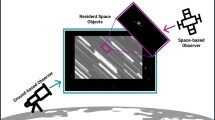Abstract
This paper is based on the second problem of the 8th China Space Trajectory Design Competition (CTOC8). The background is LEO constellation design strategy for monitoring discrete multi-targets with small satellite under J2 model. The difficulty is that the small satellite is equipped with low-cost cameras with limited coverage ability and the targets are distributed separately in a key area, which result in long revisit time or large number of satellites based on traditional design method. In this paper, a specific LEO constellation design method is proposed to cope with the problems. First, grid search and numerical method are performed to construct a database consisting of repeating ground track orbits. Then several orbits are carefully selected by pruning method to visit each target. Finally, repeating ground track constellation is constructed to meet the maximum revisit time constraint. The present method provides a systematic constellation design methodology of remote sensing observation with limited coverage ability, and demonstrates the resulting constellation can obtain rapid revisit frequency over discrete multi-targets with the least number of satellites.
Similar content being viewed by others
Change history
11 February 2022
A Correction to this paper has been published: https://doi.org/10.1007/s42064-022-0136-2
References
Walker, J. G. Satellite constellations. Journal of the British Interplanetary Society, 1984, 37: 559–572.
Ballard, A. H. Rosette constellations of earth satellites. IEEE Transactions on Aerospace and Electronic Systems, 1980, 16(5): 656–673.
Rider, L. Optimized polar orbit constellations for redundant earth coverage. Journal of the Astronautical Sciences, 1985, 33(2): 147–161.
Adams, W. S., Rider, L. Circular polar constellations providing continuous single or multiple coverage above a specified latitude. Journal of the Astronautical Sciences, 1987, 35(2): 155–192.
Draim, J. E. Three-and four-satellite continuouscoverage constellations. Journal of Guidance, Control, and Dynamics, 1985, 8(6): 725–730.
Draim, J. E. A common-period four-satellite continuous global coverage constellation. Journal of Guidance, Control, and Dynamics, 1987, 10(5): 492–499.
Mortari, D., Wilkins, M. P. Flower constellation set theory. Part I: Compatibility and phasing. IEEE Transactions on Aerospace and Electronic Systems, 2008, 44(3): 953–962.
Wilkins, M. P., Mortari, D. Flower constellation set theory. Part II: Secondary paths and equivalency. IEEE Transactions on Aerospace and Electronic Systems, 2008, 44(3): 964–976.
Ulybyshev, Y. Satellite constellation design for complex coverage. Journal of Spacecraft and Rockets, 2008, 45(4): 843–849.
Circi, C., Ortore, E., Bunkheila, F. Satellite constellations in sliding ground track orbits. Aerospace Science and Technology, 2014, 39: 395–402.
Frayssinhes, E. Investigating new satellite constellation geometries with genetic algorithms. In: Proceedings of the Astrodynamics Conference, Guidance, Navigation, and Control and Co-located Conferences, 1996: 582–586.
Ely, T. A., Crossley, W. A., Williams, E. A. Satellite constellation design for zonal coverage using genetic algorithms. Journal of the Astronautical Sciences, 1999, 47(3-4): 207–228.
Williams, E. A., Crossley, W. A., Lang, T. J. Average and maximum revisit time trade studies for satellite constellations using a multiobjective genetic algorithm. Journal of the Astronautical Sciences, 2001, 49(3): 385–400.
Savitri, T., Kim, Y., Jo, S., Bang, H. Satellite constellation orbit design optimization with combined genetic algorithm and semianalytical approach. International Journal of Aerospace Engineering, 2017, 2017: 1235692.
Zhang, Y. L., Fan, L., Zhang, Y., Xiang, J. H. Theory and Design of Satellite Constellations. Beijing: Science Press, 2008.
Wilkins, M. P. The fiower constellations Theory, design process, and applications. Ph.D. Thesis. Texas A&M University, 2007.
Eagle, D. Repeating ground track orbit design. Available at http://cn.mathworks.com/matlabcentral/fileexchange/39086-repeating-groundtrack-orbit-design.
Jiang, F., Chen, Y., Liu, Y., Baoyin, H., Li, J. GTOC5: Results from the Tsinghua University. Acta Futura, 2014, 8: 37–44.
Xiang, J. H. Study on control and design of configuration for satellite constellation. Ph.D. Thesis. National University of Defence Technology, 2007.
Schaub, H., Junkins, J. L. Analytical Mechanics of Space Systems, 2nd edn. AIAA Education, 2003.
Acknowledgements
This work was supported by the National Natural Science Foundation of China (Grant No. 91438206).
Author information
Authors and Affiliations
Corresponding author
Additional information
Chen Zhang received his B.S. degree from Northwestern Polytechnical University, Xi'an, China, in 2008, and Ph.D. degree in astrodynamics from Beihang University, China, in 2016. Currently, he is a postdoctoral fellow at Tsinghua Space Center of Tsinghua University. His area of expertise is in low thrust trajectory optimization, three-body problem, and constellation design.
Jin Jin received his Ph.D. degree in navigation, guidance, and control from Beijing Institute of Technology, China, in 2011. After two years as a postdoctoral research assistant in Tsinghua University, he joined Tsinghua Space Center of Tsinghua University as an assistant professor in 2013. Currently, he is an associate researcher. His research interests are space mission design, spacecraft dynamics, and control
Linling Kuang received her B.S. and M.S. degrees from National University of Defense Techonology, Changsha, China, in 1995 and 1998, respectively, and Ph.D. degree in electronic engineering from Tsinghua University, Beijing, China, in 2004. Since 2007, she has been with Tsinghua University, where she is currently a professor in Tsinghua Space Center. Her research interests include wireless broadband communications, signal processing, and satellite communication. Dr. Kuang is a member of the IEEE Communications Society.
Jian Yan received his B.S., M.S., and Ph.D. degrees from Tsinghua University, Beijing, China, in 1998, 2000, and 2010, respectively. From 2001 to 2011, he was with the Department of Electronic Engineering, Tsinghua University. Since August 2011, he has been working with Tsinghua Space Center of Tsinghua University, as an associate researcher. His research interests lie in the area of satellite communications.
Rights and permissions
About this article
Cite this article
Zhang, C., Jin, J., Kuang , L. et al. LEO constellation design methodology for observing multi-targets. Astrodyn 2, 121–131 (2018). https://doi.org/10.1007/s42064-017-0015-4
Received:
Accepted:
Published:
Issue Date:
DOI: https://doi.org/10.1007/s42064-017-0015-4




